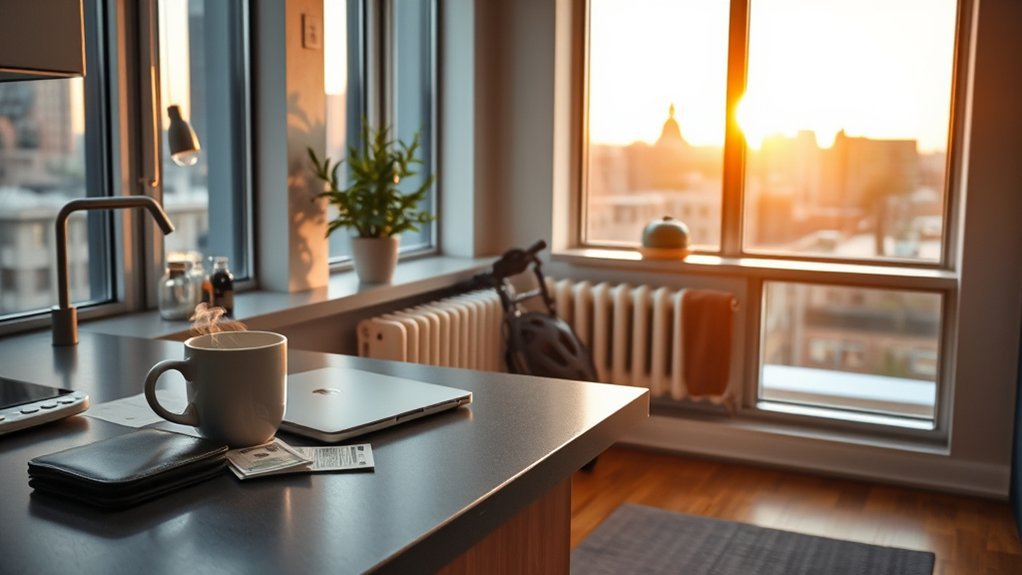Picture waking up in a St. Paul rowhouse with snow-dusted roofs and a meter humming away; you’ll want solid numbers before you sign anything. You’ll see rent typically between about $1,260–$1,830 for a typical unit, utilities and connectivity near $359, groceries a bit above the U.S. average, and transport costs around $374 — totals that shape a practical monthly budget of roughly $4,467 for a comfortable single-renter. Want the breakdown next?
Cost of Living Snapshot for Saint Paul

Although St. Paul’s overall cost of living index sits about 6% below the U.S. average and roughly 2% below Minnesota, you’ll want precise figures to plan. Your average monthly rent ranges between $1,261 and $1,526 depending on source, while typical renter housing expense is about $1,832 per month—numbers you should compare to other budget lines. The median household income is approximately $69,919–$73,055, and a single adult’s comfortable pre-tax target is near $53,600 annually; use those to gauge affordability ratios.
Monthly basic household expenses for a renter average roughly $4,467 (groceries $726, housing ~$1,832, utilities $359, transportation $374, healthcare $136). Groceries run about 4.8–5% above national average, whereas utilities, transportation, and healthcare are a few percent below or modestly lower. Use these data points to adjust budgets and assess whether St. Paul’s lower cost of living index matches your income and lifestyle. Additionally, understanding building costs in different regions can help inform better financial decisions when considering home ownership.
Housing: Renting vs. Buying Costs

When weighing renting against buying in St. Paul, you’ll find clear numbers to guide a decision. Rent runs about $1,261–$1,526/month, and many listings or new apartments make moving to a new city straightforward.
Typical renter household housing expenses land near $1,832/month, while homeowner housing costs average about $1,811/month—so monthly outlays can be similar once you include taxes, insurance, and maintenance. Median home listing prices sit around $403,000–$404,000, roughly 22% below U.S. medians; using a 6.90% mortgage rate, monthly mortgage payments plus ownership costs often match or slightly undercut comparable rent.
Because housing is 15–22% cheaper than the national average, you get buying power here that can justify a purchase if you’ll stay several years. If you prefer flexibility or aren’t settled in the new city, renting lowers upfront cash needs; if you plan long-term, buying can build equity at similar monthly cost. Additionally, retainer replacement costs can be an unexpected expense that impacts your overall budget if you have orthodontic needs.
Monthly Essentials: Utilities, Food, and Transportation

Now that you’ve compared rent and mortgage figures, look next at the monthly basics that keep a household running: utilities, food, and getting around. You’ll see the local cost of living is nuanced: monthly utilities average about $193 for energy and roughly $192 for phone service, leaving overall utilities ~4.8–4.9% below the national average.
After rent vs. mortgage, next compare monthly essentials—utilities, food, and transport—to fine-tune your St. Paul budget.
Typical renter utility bundles (energy, water, internet, phone) run about $359/month.
- Expect groceries slightly above U.S. norms; the average cost of groceries is ~4.8–5.0% higher.
- Example grocery prices: a dozen eggs ~$3.81–$4.59, a gallon of milk ~$4.56–$4.64.
- Transportation is modestly cheaper: gas ~$3.09–$3.16/gal and renter transportation about $374/month.
- Combine these lines to budget realistically: renters often allocate ~$359 (utilities) + groceries + $374 (transport) into monthly planning.
Additionally, consider that operating a group home in St. Paul may involve significant expenses that could impact the local economy.
Use these data points to adjust your St. Paul budget accurately.
Healthcare, Goods & Services, and Everyday Expenses

Because healthcare and everyday services add predictable line items to your monthly budget, plan for roughly $136/month in healthcare if you rent (about $390 if you own), plus goods and services averaging about $1,040/month for renters and $2,604 for homeowners.
You’ll see variation: an average doctor visit runs about $169, a dentist visit ~$101, and an optometrist ~$118. Over‑the‑counter pain relief is roughly $11, while prescription drugs average $19.57. Those line items feed into the overall average cost of living in St. Paul and should be tracked alongside rent and utilities.
Goods & services totals include routine purchases—haircuts (~$29), dry cleaning (~$18), movie tickets (~$11.65)—and local pricing sits about 2–3% below the U.S. average. Still, some categories spike—shampoo +30%, yoga classes +48%—so plan discretionary spending accordingly. Additionally, budgeting for repair costs can help manage unexpected expenses related to technology in education.
Use these figures to adjust your monthly forecasts and avoid surprises when scheduling care or buying services.
Salary Targets and Budgeting for Different Household Types

Although your exact needs depend on household size and ownership status, you should target specific pre-tax salary and monthly budgets to cover St. Paul living costs. If you’re a single adult, aim for a pre-tax salary near $53,604/year; expect monthly housing costs of about $1,832 and basic household expenses around $4,467. If you own a home, homeowner housing costs average $1,811/month but basic household expenses climb to roughly $7,836/month.
- Single renter: pre-tax salary ~$53,604; monthly housing costs $1,832; plan basic household expenses $4,467.
- Homeowner adult: adjust income for higher basic household expenses $7,836 despite similar housing costs $1,811.
- Married with kids under 6: monthly housing $1,783; groceries $1,409; utilities $760; transportation $757.
- Married with kids 6–17: monthly housing ~$1,954; groceries $1,648; utilities $828; transportation $871; goods & services higher.
Use these figures to set savings, taxes, and discretionary spending targets. Additionally, consider budgeting for legal fees if you anticipate any estate planning needs in your future.
Frequently Asked Questions
What Is the Average Cost of Living in St Paul MN?
The average cost of living in St. Paul runs about 6% below the U.S. average; you’ll need roughly $4,467/month as a renter or about $7,836/month as a homeowner, with typical rents near $1,300–$1,800.
What Is Considered Affordable Housing in St. Paul?
Affordable housing in St. Paul means you’ll spend about 30% or less of income on housing — roughly $1,341/month for a single adult earning ~$53,600, higher for median households, plus utilities to meet that cap.
What Is the Cost of Living in Minnesota per Month?
You’ll pay roughly $3,700–4,500 per month in Minnesota, and coincidentally that matches regional estimates; use $4,467 as a data-driven guide for a comfortable single-adult budget covering rent, groceries, utilities, transport, healthcare.
What Is the Average Cost of Living Expenses?
You’d typically spend about $4,467 monthly as a single renter in St. Paul, covering roughly $1,832 rent, $359 utilities, groceries a bit above average, and other essentials; homeowners average about $7,836 monthly.
Conclusion
You’ll find Saint Paul’s costs modestly below state and national averages, but don’t let that lull you—typical renter housing runs about $1,832/month while many report average rents of $1,261–$1,526. Factor in utilities, food, transport and basics and a comfortable single-renter budget lands near $4,467/month (about $53,600/year pre-tax). That single-number helps you compare neighborhoods, set realistic salary targets, and plan savings without surprises.


